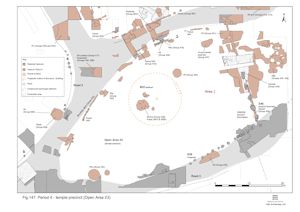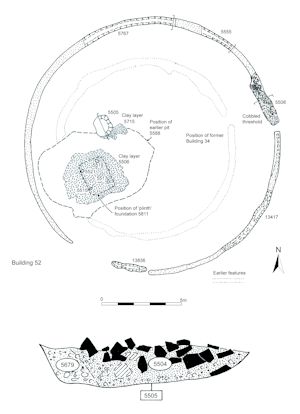
The earlier part of Period 4 is characterised by both continuity and change (Figure 147). The replacement circular temple (Building 52) stands throughout the 2nd and 3rd centuries, and beyond, though internal changes are evident. Outside, the location and content of pits within the precinct indicate changing depositional (and perhaps devotional?) practices.
Further, and generally later, mid-Roman developments within OA23 are described in OA23 (later).

Compared to the clustered pitting of Period 3, that of the mid-Roman period is more dispersed and demonstrates a shift of depositional practice to the peripheries of the temple precinct - particularly the northern. This northward shift is represented by sizeable pits 5510 (Group 416), and 5524 and 5940 (Group 420) that are positioned along the edge of Road 4. Though they differ in shape, all these pits are large and generally shallow, and are characterised by the incidence of tesserae, along with quantities of tile, in their fills. Pits 5524 and 5940 also contain chicken bones and oyster and a small range of other artefacts (e.g. padlock key SF2746, ceramic counter SF6576, glass bead SF35557, iron blade SF3567) that may be deliberately deposited or at least be the discarded debris from religious practice conducted within the precinct.
Pit 5145, although of mid-Roman date, is clearly the latest component of the otherwise Period 3 pit cluster next to the temple entrance (i.e. Group 409). It is thus clear that the relocation of pit digging within the precinct occurs by the start of the 3rd century, if not slightly earlier. As is the case with the earlier clustered pits, a ritual function is indicated by old sheep and chicken remains in this pit and the presence of a stylus and iron door hinge base (SF563) are therefore likely to be significant too. The presence of substantial quantities of tile, tesserae and iron nails is also noted. Furthermore, the 4kg of oyster shell, rarely collected in quantity from any pit across the site, is also speculated to be deliberately deposited.
The line of often-truncated slot 25069/25225 (segs 5201, 5442, 5461, 5639) is traced alongside Roads 2 and 4 for a distance of c. 58m and probably represents the foundation of a fenceline (Group 418) along the northern side of Open Area 23. Some 0.25-0.35m wide and 0.10m deep, it is cut by a number of post-holes (5186, 5218, 5444, 5446, 5452, 5455, 5634, 5650, 5652, 5697, 5700), which may be integral to the fence structure. It is likely that the fenceline is a continuous boundary although, as neither end was located, its relationship with the wall across the east side of the precinct remains undetermined. Judging by the degree of truncation by mid-Roman pits and its replacement by later Period 4 boundary ditch 25070 (Group 422), Structure 45 is probably the first of the major temple precinct boundaries of this period; although fragmentary remains of post-hole lines suggest the presence of earlier structures along the same line, probably belonging to Period 3B.
Structure 45 can be dated by the small amounts of pottery recovered from both 25069 (segs 5442, 5639) and 25225 (seg. 5201) and from post-holes 5186, 5218 and 5452, which range in date from the early/mid-3rd century into the early 4th century. However, fragmentary remains of post-hole alignments suggest earlier structures along the same line, probably belonging to Period 3B (it should be noted that 5444, 5455, 5446, 5634, 5650, 5652, 5697, 5700 could, on purely stratigraphic criteria, be as early as Period 2B).

Following the reduction of the mortared plinth 5811/13520 and infilling of pit 5588/13432, the whole is levelled off and capped with orange clay deposit 5506/13428. A wooden post-built structure (Structure 47 Group 428) is then placed directly over the former site of the plinth; its four post-holes, 5515, 5517, 5519 and 5521, penetrating the clay capping and using the underlying truncated plinth foundation to provide a solid footing. The post-holes describe a rectangle of 1.2m by 1.4m and, given its location, it is reasonable to assume that these are the remains of a replacement shrine within the still-standing circular temple Building 52.
To the north-east of this new shrine-like structure is almost-square cut 5505 (also Group 428). Like the four post-holes, it is cut through the clay capping deposit. It is 'packed' with tile and stone rubble and is presumably a setting for a timber upright. A similar feature was recorded on the southern edge of the clay capping during the evaluation stage (feature 3910, Trial Trench 7), but seems to have been removed or lost during the subsequent machine stripping of Area A1. Features 3910 and 5505 could conceivably be the remains of a structure associated with the four-post 'shrine', perhaps forming a housing or canopy around/over it.
Internet Archaeology is an open access journal based in the Department of Archaeology, University of York. Except where otherwise noted, content from this work may be used under the terms of the Creative Commons Attribution 3.0 (CC BY) Unported licence, which permits unrestricted use, distribution, and reproduction in any medium, provided that attribution to the author(s), the title of the work, the Internet Archaeology journal and the relevant URL/DOI are given.
Terms and Conditions | Legal Statements | Privacy Policy | Cookies Policy | Citing Internet Archaeology
Internet Archaeology content is preserved for the long term with the Archaeology Data Service. Help sustain and support open access publication by donating to our Open Access Archaeology Fund.